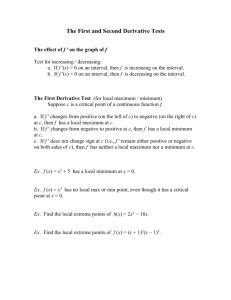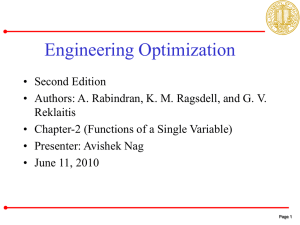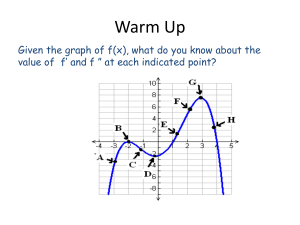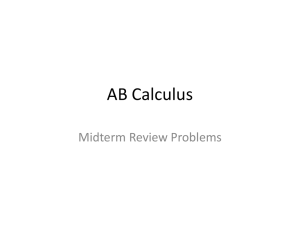Summary of First and Second Derivative tests
advertisement
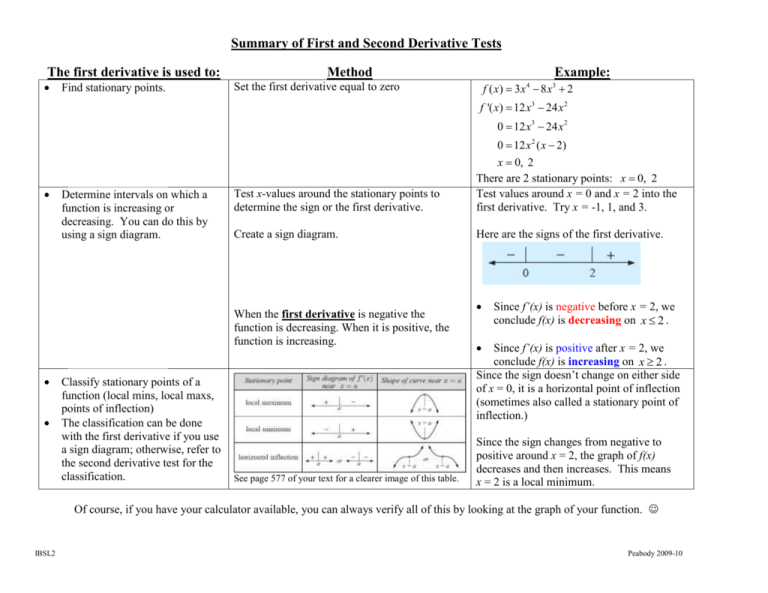
Summary of First and Second Derivative Tests The first derivative is used to: Find stationary points. Method Example: f ( x) 3x 8 x 2 Set the first derivative equal to zero 4 3 f '( x) 12 x 3 24 x 2 0 12 x 3 24 x 2 0 12 x 2 ( x 2) Determine intervals on which a function is increasing or decreasing. You can do this by using a sign diagram. Test x-values around the stationary points to determine the sign or the first derivative. x 0, 2 There are 2 stationary points: x 0, 2 Test values around x = 0 and x = 2 into the first derivative. Try x = -1, 1, and 3. Create a sign diagram. Here are the signs of the first derivative. When the first derivative is negative the function is decreasing. When it is positive, the function is increasing. Classify stationary points of a function (local mins, local maxs, points of inflection) The classification can be done with the first derivative if you use a sign diagram; otherwise, refer to the second derivative test for the classification. See page 577 of your text for a clearer image of this table. Since f’(x) is negative before x = 2, we conclude f(x) is decreasing on x 2 . Since f’(x) is positive after x = 2, we conclude f(x) is increasing on x 2 . Since the sign doesn’t change on either side of x = 0, it is a horizontal point of inflection (sometimes also called a stationary point of inflection.) Since the sign changes from negative to positive around x = 2, the graph of f(x) decreases and then increases. This means x = 2 is a local minimum. Of course, if you have your calculator available, you can always verify all of this by looking at the graph of your function. IBSL2 Peabody 2009-10 The second derivative is used to: Find all points of inflection. Method Example: f ( x) 3x 8 x 2 Find all the points of inflection by setting the second derivative equal to zero. 4 3 f '( x) 12 x 3 24 x 2 f "( x) 36 x 2 48 x 0 36 x 2 48 x 0 12 x(3 x 4) x 0, Classify points of inflection (either horizontal or stationary points of inflection or non-horizontal, nonstationary points of inflection) Note that in either case, a point of inflection is a point at which the concavity of the graph changes. Determine the intervals on which a function is concave up or down. You can do this through use of a sign diagram testing signs of the second derivative on either side of the points of inflection. 4 3 If both first and second derivative are zero, then the point is a horizontal point of inflection (or stationary point of inflection). Since f '(0) 0 and f "(0) 0 , x = 0 is a horizontal point of inflection. If only the second derivative is zero, then the point is a non-horizontal (or non-stationary) point of inflection. Since f '( 43 ) 0 while f "( 43 ) 0 , x 43 is a nonhorizontal (or non-stationary) point of inflection Test x-values around the points of inflection to determine the sign or the second derivative. Test values around x = 0 and x 43 into the second derivative. Try x = -1, 1, and 2. Create a sign diagram. Here are the signs of the second derivative. + 0 When the second derivative is positive, the function is concave up. When it is negative the function is concave down. IBSL2 + 4 3 Since f’(x) is positive before x = 0 and after x 43 the graph is concave up on the intervals x 0, and x 43 Since f’(x) is negative between x = 0 and x 43 , the graph is concave down on the interval 0 x 43 . Peabody 2009-10 Classify stationary points of a function (local mins, local maxs, points of inflection) To use the second derivative to classify stationary points, simply test the stationary point into the second derivative. If the result is positive, then the graph is concave up. Hence, the stationary point is a local minimum. If the result is negative, then the graph is concave down. Hence the stationary point is a local maximum. f ( x) 3x 4 8 x3 2 f '( x) 12 x 3 24 x 2 f "( x) 36 x 2 48 x 12 x(3 x 4) From our earlier work, we found two stationary points: one at x = 0 and the other at x = 2. Testing these into the second derivative, we get: For x = 0: If the result is zero, then the point is a horizontal point of inflection. f "( x) 12 x(3x 4) f "(0) 0(4) So x = 0 is a point of inflection. 0 Note that we needed a sign chart with the first derivative to come to this conclusion earlier. f "( x) 12 x(3 x 4) For x = 2: f "(2) 24(6 4) positive Since the result is positive, the graph is concave up at x = 2. This means that x = 2 is a local minimum. Again, the same conclusion can be reached by using a sign chart with the first derivative. This is the real math-y stuff you need for the quiz. You also need to understand how all of it relates to physical situations involving displacement, velocity and acceleration, etc. The charts on page 567 of your textbook seem particularly useful for this. If you are looking for extra problems for review, you should be able to now complete the following from your text: Review Set 22A: Q1, Q2, Q3, Q4, Q6, Q8, Q11 Review Set 22B: Q2, Q3, Q4, Q6 IBSL2 Peabody 2009-10



